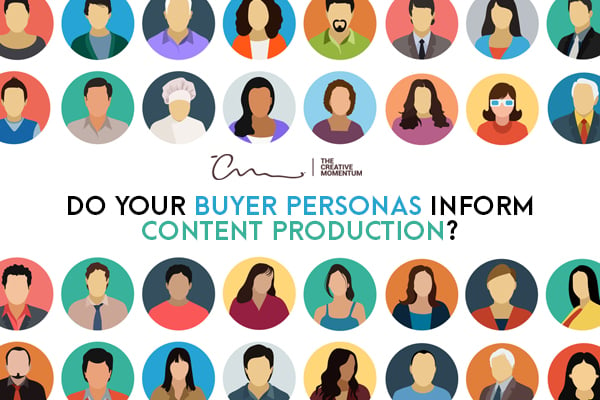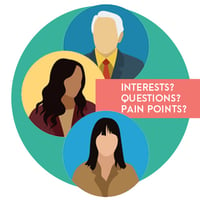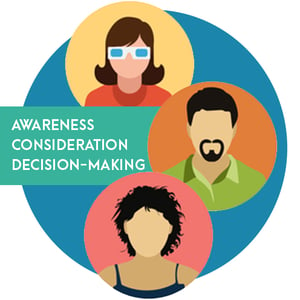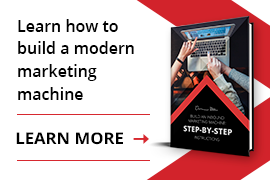 Buyer personas are powerful marketing tools, but they’re not always utilized well. If you don’t use them to inform your content production—or at all—your marketing won’t reach its full potential.
Buyer personas are powerful marketing tools, but they’re not always utilized well. If you don’t use them to inform your content production—or at all—your marketing won’t reach its full potential.
What are Buyer Personas?
Buyer personas are semi-fictional characters who represent your ideal customers. Their names and backgrounds are made up, but their behaviors, motivations, and goals are based on real data from your existing customers. The more detailed you make them, the more effective they’ll be. Think of them as a cheat sheet about how to engage with the perfect customers.
Use your personas to guide you through every stage of marketing. From strategy planning and website design to social media and content production, they’ll show you how to create the perfect content.
Are Buyer Personas Really That Important?
If you sell workout equipment, for example, it’s much easier to cater content to Joan, working mother of three who’s looking for ways to stay fit with her busy schedule, than to “male 45%, female 55%, age 25-34.”
You know Joan. You know her priorities, you know her pain points, and you know exactly how to craft content to answer her questions and engage with her on a personal level. A blog about quick and easy workout tips would probably be quite effective. General demographic statistics just don’t paint the same (detailed) picture.
General demographic statistics just don’t paint the same (detailed) picture.
By creating buyer personas, you have a marketing goal. You better visualize the exact person(s) you're targeting. Almost two-thirds of businesses that regularly exceed their revenue and lead goals use documented personas to inform their marketing decisions.
Build a Content Strategy that Caters to Your Buyer Personas
Creating a content strategy is all about getting:
- the right message to
- the right people at
- the right time.
Should you write blogs, or would videos be more effective? Do you need to use social media, and if so, which platforms? If you have detailed buyer personas, these answers come more easily.
Once you know the best channels to use, it’s time to come up with content topics. Again, look to your buyer personas. Think about their interests, questions, and pain points, then create broad topic clusters that address their core concerns. The more concerns you address, the more customers you’ll attract. Since you’re focusing on your ideal customers, those are the types of people you’ll attract.
It’s also helpful to develop negative buyer personas: fictional representations of the customers who benefit your business the least. Sometimes knowing who you don’t want to attract is just as important as knowing your ideal customer. Negative personas will help you avoid the customers who just bog down your business with complaints, noisy phone calls, and bad reviews. Every time you experience a bad client, take note of his or her demographic information. You might start to notice trends and be able to craft a negative buyer persona. Then, when making your content strategy, you can avoid the channels and topics that would attract that type of customer to your business.
Create Content for Each Phase of the Inbound Process
After you've created your buyer personas, it's time to create the content. Look at your broad topic clusters and break them into multiple subtopics. For marketers who don’t use buyer personas, topic generation can be quite frustrating. Ideas don’t grow on trees! But your buyer personas can simplify the process.
Separate your subtopics into phases of the buyer’s journey. With each piece of content, ask: what are we trying to achieve? Are you providing general information, creating awareness of your product or service, or scheduling a live demo?
1. Awareness Stage
The awareness stage is what draws customers in. It’s the content they look for when they encounter a vague problem and head to the internet for answers. This content should provide basic answers to your personas’ concerns.
Your buyer personas will help you determine the best places to push this content for maximum reach. Is it social media? Is it your website? What about email blasts? Joan, working mother of three, might not have time to scour the internet looking for answers, but she does spend time on Instagram while waiting to pick her kids up at school.
2. Consideration Stage
n the consideration stage, customers know their problem and are researching solutions. They’re just not sure which solution fits their needs.
As customers go down the sales funnel, their needs change. This is where buyer persona segmentation will help. Separating your ideal customers into different categories (personas) can help you create content that appeals to specific demographics.
Joan, working mother of three, will go through the consideration stage differently than John, childless executive. Cost-effectiveness might play a larger role for Joan, while John might be more interested in features. Think about what’s most important to your various buyer personas and create content that appeals to each.
3. Decision-Making Stage
The decision-making stage is the last step before a customer presses the “buy now” button. Customers in this stage know what their problem is, and they know the solution, but they haven’t decided who they’re going to turn to. This is where you include case studies, vendor comparisons, product demos, and your most proven sales strategies that put you above the competition.
But, one sales tactic doesn’t work for all buyers. Again, let your buyer personas guide you as you create effective bottom-of-the-funnel content. Think about their likes and dislikes and craft content specific for each persona. Aggressive, no-nonsense sales tactics might appeal to John, but they could scare Joan off to a competitor. If you have bottom-of-the-funnel content that appeals to all your ideal customers, you’ll have more sales and leads than you know what to do with.
Content Production Benefits from Buyer Personas
If you struggle to create compelling content, you're probably not using buyer personas effectively. They're not just a fun little project to work on when creating a business; they're roadmaps for creating engaging content that attracts the perfect customers.

